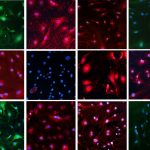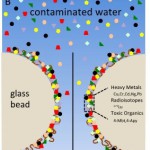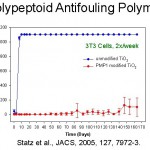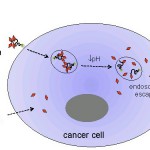Research
Mussel-Inspired Adhesives
We exploit information gained from our basic studies of mussel adhesion for the design of synthetic adhesives. Typically, synthetic polymers are chemically derivatized with catechols in the form of DOPA, DOPA peptides, or DOPA-mimetic functional groups (Figure). This approach allows us to employ standard polymer synthetic strategies and to confer the important properties of catechols …
Regenerative and Reparative Medicine
We are developing novel hydrogels and other materials for use in regenerative medicine and general surgery. These hydrogels frequently are designed to solidify in-situ for bonding of tissues together, for attaching medical devices to tissues, and for sealing wounds or surgically created defects in tissue membranes. Often we take advantage of mussel-inspired chemistry to form …
Multifunctional Catechol Coatings
We are developing a family of coatings by exploiting the chemical diversity of catechols for attachment onto many different organic and inorganic surfaces, and for conferring a variety of functional uses. In a landmark paper (Science, 2007), we reported the formation of coatings from alkaline oxidative polymerization of dopamine. These “polydopamine” coatings are simple to …
Antifouling/Antibacterial Coatings
Biofouling, the process of deposition of living and nonliving matter on surfaces, is a common occurrence in the biological world and impacts many technologies. In many cases, biofouling is highly undesirable and has adverse consequences. In the case of marine coatings, fouling of ship hulls by microscopic (algae) or macroscopic (barnacles, mussels) organisms interferes with …
Mechanochemistry of Adhesion
Interfacial Mechanochemistry of Biological Adhesives We are using single molecule force spectroscopy to probe the interaction of adhesive biomolecules with surfaces (see Figure). In this method, and atomic force microscope (AFM) cantilever is functionalized with an inert grafted polymer with a small fraction of grafted polymers terminally functionalized with the biomolecule of interest (e.g. amino …
Drug Delivery
In the area of drug delivery, we focus on design of polymers for controlled delivery of therapeutic agents. One interest of ours is in designing pH-sensitive delivery systems whereby delivery of a therapeutic is facilitated by reduction in pH such as is observed in the tumor interstitium or in the endosome. Recently, we developed catechol-containing …
Nanomedicine
The performance and biological fate of nanoparticles deployed in a medical context is strongly dependent on surface properties. We are developing novel surface modification strategies for use in controlling biointerfacial phenomena related to therapeutic and diagnostic nanoparticles. In one project, we are using polydopamine coatings as primers to functionalize gold nanorods with antibodies for cancer …
Warning: count(): Parameter must be an array or an object that implements Countable in /services/http/users/m/messrsch/wordpress/wp-includes/class-wp-comment-query.php on line 405







